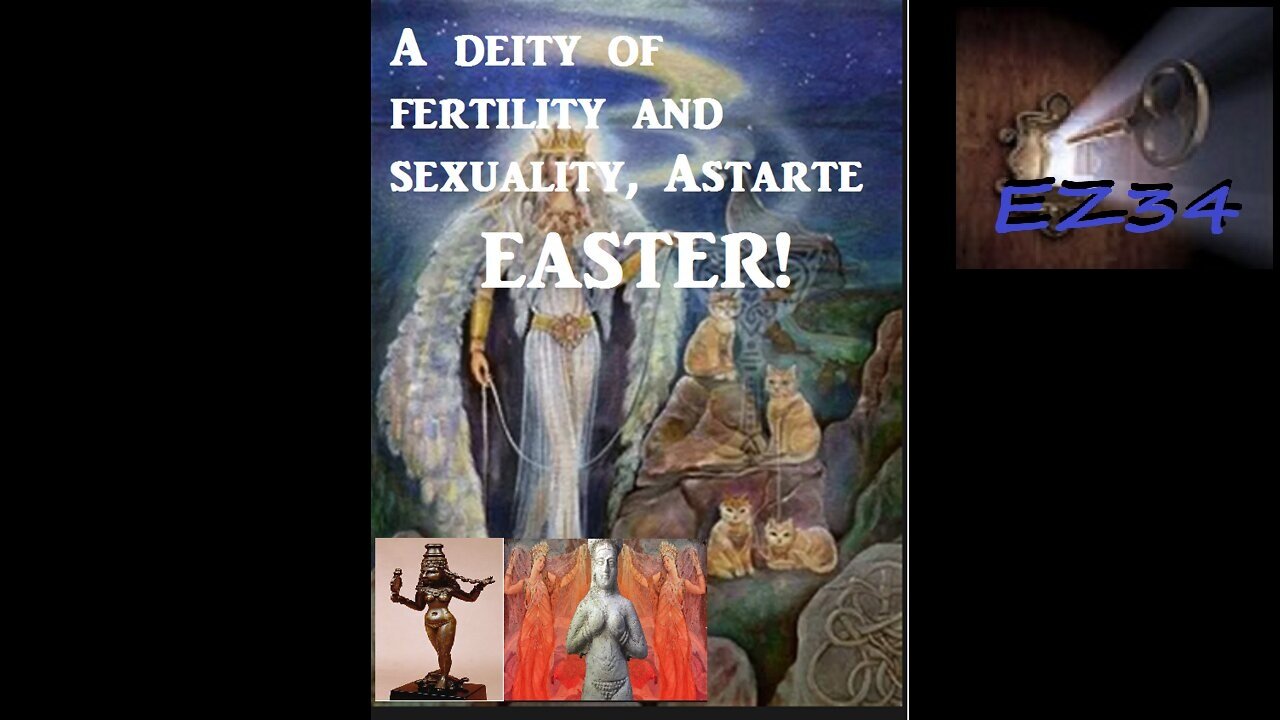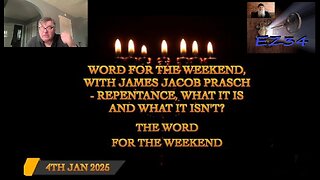Premium Only Content

The True Origin of Easter aka as "Ashtoreth" Ishtar'_Easter Exposed—What Does God Say-You may be really shocked here.
https://rumble.com/c/Ezek34
https://www.bitchute.com/channel/HTTdIuOFFTjf/
https://www.brighteon.com/channels/ezek34
VERY IMPORTANT EDUCATIONAL LESSON!_(Comment)__ Those that worship me know not they worship me in vain.__Hosea 4:6-" My people are destroyed for lack of knowledge". Also
remember what GOD said about keeping MAN'S TRADITIONS. This may not settle well with people of traditions.
Albeit i am non-denominational. Strictly scripture, I do like this presentation of material on Easter. It is correct._I personally observe Passover followed by Feast of UN-Leavened Bread as biblical instructed to do so. This is not a misnomer!. "This IS NOT JEWISH LAW ONLY or Old Testament LAWS as misunderstood by latter day- end times Church teachings. "Oh that's biblical old testament laws for the Jews, doesn't apply to Gentiles."- WRONG! This is God's Law everlasting to the LAST GENERATION!"_ Be the true Church, the true chosen of God, be separate it is commanded. Yes i liked Xmas, Easter etc.. I had to come out of traditions of men. Paganism things of the world.You should as well. Yes, once I did not know either on these things__May this Edify-.Blessings.....Ezek34__
2ndTim 4__I charge thee therefore before God, and the Lord Jesus Christ, who shall judge the quick and the dead at his appearing and his kingdom; 2.Preach the word; be instant in season, out of season; reprove, rebuke, exhort with all longsuffering and doctrine. 3.For the time will come when they will not endure sound doctrine; but after their own lusts shall they heap to themselves teachers, having itching ears; 4.And they shall turn away their ears from the truth, and shall be turned unto fables. 5.But watch thou in all things, endure afflictions, do the work of an evangelist, make full proof of thy ministry.__
LINK FOR ALL MATERIAL__
https://rcg.org/books/ttooe.html
https://www.learnreligions.com/who-is-astarte-2561500
https://www.learnreligions.com/is-easter-a-christian-or-pagan-holiday-249845
https://www.learnreligions.com/all-about-passover-pesach-2076435
See also America's Occult Holidays....
https://rumble.com/vwuymz-americas-occult-holidays-full-length-speaker-doc-marquis.html__
and also...
https://rumble.com/v11nrbr-the-first-passover-and-the-return-of-jesus-.html
Also...
https://rumble.com/v11elzd-the-five-pascal-sedars-word-for-the-weekend-jacob-prasch.html
A Brief Look at Passover
The well-known Old Testament Passover story centers on God’s deliverance of Israel from Egypt through ten miraculous plagues. These included how the death angel would “pass over” all the houses where the Israelite's lived. They were instructed to put blood over their doorposts to ensure that only the firstborn of Egypt would die. In this first Passover, it was only the blood of the slain lamb that protected each Israelite home. While Egypt suffered the plague of death, the Israelite firstborn were delivered by blood. By obeying God’s command and by faith in His promise to protect them, they were spared from death.
The Passover account is found in Exodus 12:12-14. Verse 14 states that the Passover ceremony was commanded by God to be an annual memorial feast to be kept by Israel “forever.” (This command is repeated in Leviticus 23:5.) Exodus 12:15 introduces the seven-day festival called the Days of Unleavened Bread (also repeated in Leviticus 23:6-8), which was to immediately follow the Passover feast each year. This is why Acts 12:3 states, “Then were the days of unleavened bread,” before mentioning the Passover in the next verse. These days were always kept in conjunction with one another.
What About the New Testament?__
If the Passover was instituted forever, then New Testament instruction for its observance should be clear. This instruction is found in I Corinthians 5:7-8: “Purge out therefore the old leaven, that you may be a new lump, as you are unleavened. For even Christ our Passover is sacrificed for us: Therefore let us keep the feast [of unleavened bread, which always followed Passover, as explained above]…”
Christ, as the Lamb of God (John 1:29; Acts 8:32; I Peter 1:19; Rev. 5:6), replaced the Old Testament lamb eaten on Passover evening each year. The New Testament symbols of the bread and wine were instituted so that Christians could eat the body and drink the blood of Christ, the true Lamb of God. Jesus’ sacrifice replaced the need to kill a spring lamb. Luke 22:19 shows that Jesus substituted the bread and wine to be taken annually in commemoration of His sacrifice for the remission of our sins—both spiritual and physical.__
Early Christians kept the Passover, not Easter. Notice this from the Encyclopaedia Britannica, 11th edit., Vol. 8, p. 828: “There is no indication of the observance of the Easter festival in the New Testament, or in the writings of the Apostolic Fathers…The first Christians continued to observe the Jewish festivals [God’s festivals of Leviticus 23], though in a new spirit, as commemorations of events which those festivals had foreshadowed. Thus the Passover, with a new conception added to it, of Christ as the true Paschal Lamb…continued to be observed.”__
The original apostles and early New Testament Church did not observe Easter. Notice: “In the second century AD, Easter Day was, among Christians in Asia Minor [these would be the Gentile churches that Paul raised up in places such as Philippi, Colossae, Galatia, etc.—and he warned the Galatians (4:9-10) about taking days such as Easter] the 14th of Nisan [or Abib] the seventh month of the [civil] Jewish calendar” (World Almanac, 1968 edit., p. 187). The date described here is not Easter Day, but rather the Passover—which was kept on the 14th day of the first month (Nisan) of the sacred calendar. The apostles and early Church did not observe Easter!__
Despite the overwhelming proof that God’s Holy Days, as listed in Leviticus 23, are still to be kept by Christians today (Acts 2:1; 12:3; 18:21; 20:6, 16; I Cor. 5:7-8; 16:8), almost no one who claims to believe in the God of the Bible keeps them! Almost no one who professes to worship Jesus Christ observes the Passover as He commanded! Why?__
Since instruction to observe Easter is not in the Bible, and God’s permanent command to keep Passover is, then where did Easter originate? After surveying the origin of Passover, we are ready to study the origin of Easter.
When Easter Came to America__
Easter has long been known to be a pagan festival! America’s founders knew this! A children’s book about the holiday, Easter Parade: Welcome Sweet Spring Time!, by Steve Englehart, p. 4, states, “When the Puritans came to North America, they regarded the celebration of Easter—and the celebration of Christmas—with suspicion. They knew that pagans had celebrated the return of spring long before Christians celebrated Easter…for the first two hundred years of European life in North America, only a few states, mostly in the South, paid much attention to Easter.” Not until after the Civil War did Americans begin celebrating this holiday: “Easter first became an American tradition in the 1870s” (p. 5). Remarkable! The original 13 colonies of America began as a “Christian” nation, with the cry of “No king but King Jesus!” The nation did not observe Easter within an entire century of its founding. What happened to change this?
Where Did Easter Come From?__
Does the following sound familiar?—Spring is in the air! Flowers and bunnies decorate the home. Father helps the children paint beautiful designs on eggs dyed in various colors. These eggs, which will later be hidden and searched for, are placed into lovely, seasonal baskets. The wonderful aroma of the hot cross buns mother is baking in the oven waft through the house. Forty days of abstaining from special foods will finally end the next day. The whole family picks out their Sunday best to wear to the next morning’s sunrise worship service to celebrate the savior’s resurrection and the renewal of life. Everyone looks forward to a succulent ham with all the trimmings. It will be a thrilling day. After all, it is one of the most important religious holidays of the year.
Easter, right? No! This is a description of an ancient Babylonian family—2,000 years before Christ—honoring the resurrection of their god, Tammuz, who was brought back from the underworld by his mother/wife, Ishtar (after whom the festival was named). As Ishtar was actually pronounced “Easter” in most Semitic dialects, it could be said that the event portrayed here is, in a sense, Easter. Of course, the occasion could easily have been a Phrygian family honoring Attis and Cybele, or perhaps a Phoenician family worshipping Adonis and Astarte. Also fitting the description well would be a heretic Israelite family honoring the Canaanite Baal and Ashtoreth. Or this depiction could just as easily represent any number of other immoral, pagan fertility celebrations of death and resurrection—including the modern Easter celebration as it has come to us through the Anglo-Saxon fertility rites of the goddess Eostre or Ostara. These are all the same festivals, separated only by time and culture.
If Easter is not found in the Bible, then where did it come from? The vast majority of ecclesiastical and secular historians agree that the name of Easter and the traditions surrounding it are deeply rooted in pagan religion.
Now notice the following powerful quotes that demonstrate more about the true origin of how the modern Easter celebration got its name:__
“Since Bede the Venerable (De ratione temporum 1:5) the origin of the term for the feast of Christ’s Resurrection has been popularly considered to be from the Anglo-Saxon Eastre, a goddess of spring…the Old High German plural for dawn, eostarun; whence has come the German Ostern, and our English Easter” (The New Catholic Encyclopedia, 1967, Vol. 5, p. 6).
“The fact that vernal festivals were general among pagan peoples no doubt had much to do with the form assumed by the Eastern festival in the Christian churches. The English term Easter is of pagan origin” (Albert Henry Newman, D.D., LL.D., A Manual of Church History, p. 299).
“On this greatest of Christian festivals, several survivals occur of ancient heathen ceremonies. To begin with, the name itself is not Christian but pagan. Ostara was the Anglo-Saxon Goddess of Spring” (Ethel L. Urlin, Festival, Holy Days, and Saints Days, p. 73).
“Easter—the name Easter comes to us from Ostera or Eostre, the Anglo-Saxon goddess of spring, for whom a spring festival was held annually, as it is from this pagan festival that some of our Easter customs have come” (Hazeltine, p. 53).
“In Babylonia…the goddess of spring was called Ishtar. She was identified with the planet Venus, which, because…[it] rises before the Sun…or sets after it…appears to love the light [this means Venus loves the sun-god]…In Phoenecia, she became Astarte; in Greece, Eostre [related to the Greek word Eos: “dawn”], and in Germany, Ostara [this comes from the German word Ost: “east,” which is the direction of dawn]” (Englehart, p. 4).
As we have seen, many names are interchangeable for the more well-known Easter. Pagans typically used many different names for the same god or goddess. Nimrod, the Bible figure who built the city of Babylon (Gen. 10:8), is an example. He was worshipped as Saturn, Vulcan, Kronos, Baal, Tammuz, Molech and others, but he was always the same god—the fire or sun god universally worshipped in nearly every ancient culture. (Read our free booklet The True Origin of Christmas to learn more about this holiday and Nimrod’s role in its early history.)
The goddess Easter was no different. She was one goddess with many names—the goddess of fertility, worshipped in spring when all life was being renewed.
The widely-known historian, Will Durant, in his famous and respected work, Story of Civilization, pp. 235, 244-245, writes, “Ishtar [Astarte to the Greeks, Ashtoreth to the Jews], interests us not only as analogue of the Egyptian Isis and prototype of the Grecian Aphrodite and the Roman Venus, but as the formal beneficiary of one of the strangest of Babylonian customs…known to us chiefly from a famous page in Herodotus: Every native woman is obliged, once in her life, to sit in the temple of Venus [Easter], and have intercourse with some stranger.”
We must now look closer at the origin of other customs associated with the modern Easter celebration.
The Origin of Lent
According to Johannes Cassianus, who wrote in the fifth century, “Howbeit you should know, that as long as the primitive church retained its perfection unbroken, this observance of Lent did not exist” (First Conference Abbot Theonas, chapter 30). There is neither biblical nor historical record of Christ, the apostles or the early Church participating in the Lenten season.
Since there is no instruction to observe Lent in the Bible, where did it come from? A forty-day abstinence period was anciently observed in honor of the pagan gods Osiris, Adonis and Tammuz (John Landseer, Sabaean Researches, pp. 111, 112). Alexander Hislops, The Two Babylons, pp. 104-105, says this of the origin of Lent: “The forty days abstinence of Lent was directly borrowed from the worshippers of the Babylonian goddess. Such a Lent of forty days, in the spring of the year, is still observed by the Yezidis or Pagan Devil-worshippers of Koordistan, who have inherited it from their early masters, the Babylonians. Such a Lent of forty days was held in spring by the Pagan Mexicans…Such a Lent of forty days was observed in Egypt…”
Lent came from paganism, not from the Bible! (To learn more about the Lenten season, read our article “The True Meaning of Lent.”)
Eggs, Egg Hunts and Easter
Eggs have always been associated with the Easter celebration. Nearly every culture in the modern world has a long tradition of coloring eggs in beautiful and different ways. I once examined a traveling display of many kinds of beautifully decorated egg designs that represented the styles and traditions of virtually every country of modern Europe.
Notice the following: “The origin of the Easter egg is based on the fertility lore of the Indo-European races…The egg to them was a symbol of spring…In Christian times the egg had bestowed upon it a religious interpretation, becoming a symbol of the rock tomb out of which Christ emerged to the new life of His resurrection” (Francis X. Weiser, Handbook of Christian Feasts and Customs, p. 233). This is a direct example of exactly how pagan symbols and customs are “Christianized,” i.e., Christian-sounding names are superimposed over pagan customs. This is done to deceive—as well as make people feel better about why they are following a custom that is not in the Bible.
Notice: “Around the Christian observance of Easter…folk customs have collected, many of which have been handed down from the ancient ceremonial…symbolism of European and Middle Eastern pagan spring festivals…for example, eggs…have been very prominent as symbols of new life and resurrection” (Encyclopaedia Britannica, 1991 ed., Vol. 4, p. 333).
Finally, the following comes from Egyptian Belief and Modern Thought, James Bonwick, pp. 211-212: “Eggs were hung up in the Egyptian temples. Bunsen calls attention to the mundane egg, the emblem of generative life, proceeding from the mouth of the great god of Egypt. The mystic egg of Babylon, hatching the Venus Ishtar, fell from heaven to the Euphrates. Dyed eggs were sacred Easter offerings in Egypt, as they are still in China and Europe. Easter, or spring, was the season of birth, terrestrial and celestial.”
What could be more plain in showing the true origin of the “Easter egg”? An “Easter” egg is just an egg that pertains to Easter. God never authorized Passover eggs or Days of Unleavened Bread eggs, but there have been Easter eggs for thousands of years!
It naturally progressed that the egg, representing spring and fertility, would be merged into an already pagan springtime festival. Connecting this symbol to Christ’s Resurrection in the spring required much creativity and human reasoning. However, even highly creative human reasoning has never been able to successfully connect the next Easter symbol to anything Christian, because there is not a single word about it anywhere in the New Testament!___
The Easter Bunny...
Here are two additional quotes from Francis Weiser about the origin of the “Easter bunny”: “In Germany and Austria little nests containing eggs, pastry and candy are placed in hidden spots, and the children believe that the Easter bunny, so popular in this country, too, had laid the eggs and brought the candy” (p. 235) and “The Easter bunny had its origin in pre-Christian fertility lore…The Easter bunny has never had religious symbolism bestowed on its festive usage…However, the bunny has acquired a cherished role in the celebration of Easter as the legendary producer of Easter eggs for children in many countries” (p. 236).
Here is further proof of the origin of Easter eggs and rabbits. It demonstrates how no one has ever been able to connect the Easter bunny to anything Christian, let alone to the Bible: “The Easter bunny is not a true Christian symbol” (John Bradner, Symbols of Church Seasons and Days, p. 52), and “Although adopted in a number of Christian cultures, the Easter bunny has never received any specific Christian interpretation” (Mirsea Eliade, The Encyclopedia of Religion, p. 558).
None of this will stop scores of millions of professing Christians from decorating their lawns and houses with Easter bunnies each spring.
Consider this last quote: “The hare, the symbol of fertility in ancient Egypt, a symbol that was kept later in Europe…Its place has been taken by the Easter rabbit” (Encyclopaedia Britannica, 1991 ed., Vol. 4, p. 333).
Even in modern times, rabbits have remained common symbols of fertility. While their rapid rate of reproduction is well known, another problem arises with rabbits—they do not lay eggs! While both are clearly fertility symbols, there is no logical way to connect them. In a world filled with pagan tradition, truth and logic can be lost. Merging these symbols with Christianity makes an already idolatrous practice worse.
There is nothing Christian about any of these symbols. The true history of these fertility symbols, rabbits and eggs, is completely unknown to all the unsuspecting children who have been led by adults to think them so special.
The entire concept that these are Christian is a lie foisted on innocent children who will believe that “the moon is made of cheese” just because someone tells them so. While these are shocking facts, they are true nonetheless.
A Counterfeit Savior?
One of the central themes of the New Testament is that Jesus Christ came to die for mankind’s sins and offer redemption to a world cut off from God.
The master counterfeiter (Satan the devil, called the “god of this world” in II Cor. 4:4) seeks to counterfeit every aspect of God’s plan. He “deceives the whole world” (Rev. 12:9). As the arch-deceiver, he would not be content to counterfeit all other aspects of Christianity but not the identity and worship of the true Savior!
Who is the real “savior” central to the “Easter Sunday” tradition? Is it the Jesus Christ of the Bible? If you say “yes,” are you sure? History answers this question plainly, with this:
First notice that “…the conception of a Saviour-God was quite normal in the ancient pagan world…a conception of salvation underlies the notion of such Gods as Osiris, Attis, and Adonis…” (John M. Robertson, Christianity and Mythology, p. 395).
And then this: “It has often been urged that this belief in the Resurrection of Jesus is due to ideas of divine resurrection current in the contemporary world…stories of Attis, Adonis, and Osiris…In the pagan stories the rising again is a joyous reversal of defeat; in the Christian story it is the complement of victorious death. It may be said that Attis and Osiris saved by rising again, Jesus by dying…the Easter observance did not arise at once out of belief in the Resurrection, but developed later by gradual stages out of the Jewish Pasch. The notion implied in the Easter greeting Christ is risen is a secondary development; the idea comes from this festival and from its occurrence in spring; the festival does not come from the idea. The idea of Christ’s resurrection was injected into the old practice of Easter observance and not the other way around” (A. Nock, Early Gentile Christianity and its Hellenistic Background, pp. 105-107).
And, finally, the powerful theme of this oft-repeated counterfeit is made most clear by the famous historian, James George Frazer: “Now the death and resurrection of Attis were officially celebrated at Rome on the 24th and 25th of March, the latter being regarded as the spring equinox, and…according to an ancient and widespread tradition Christ suffered on the 25th of March…the tradition which placed the death of Christ on the 25th of March…is all the more remarkable because astronomical considerations prove that it can have had no historical foundation…When we remember that the festival of St. George in April has replaced the ancient pagan festival of the Parilia; that the festival of St. John the Baptist in June has succeeded to a heathen Midsummer festival of water; that the festival of the Assumption of the Virgin in August has ousted the festival of Diana; that the feast of All Souls [following Halloween] in November is a continuation of an old heathen feast of the dead; and that the Nativity of Christ himself was assigned to the winter solstice in December because that day was deemed the Nativity of the Sun; we can hardly be thought to be rash or unreasonable in conjecturing that the other cardinal festival of the Christian church—the solemnization of Easter—may have been in like manner, and from like motives of edification, adapted to a similar celebration of the Phrygian god Attis at the vernal equinox…It is a remarkable coincidence…that the Christian and the heathen festivals of the divine death and resurrection should have been solemnized at the same season…It is difficult to regard the coincidence as purely accidental” (The Golden Bough, Vol. I, pp. 306-309).
We can summarize the above source. The Roman Catholic Church had a practice of incorporating pagan festivals—of pasting “Christian” names over them and calling them “Christian.” This was done to make “Christianity” more palatable and familiar to heathen worshippers, whom the Church was trying to attract. How did such a state of affairs develop?
It can now be better understood why the apostle Paul wrote the Corinthians to beware of the subtle deceit of “another Jesus whom we have not preached.” He said, “But I fear, lest by any means, as the serpent beguiled Eve through his subtilty, so your minds should be corrupted from the simplicity that is in Christ. For if he that comes preaches another Jesus, whom we have not preached, or if you receive another spirit, which you have not received, or another gospel, which you have not accepted…” (II Cor. 11:3-4).
People today can think that they are worshipping the true Savior when they are really worshipping a false savior—another Jesus! The entirety of traditional Christianity is actually worshipping Baal, the mediator and sun god, who was named after his “wife” Ishtar (who was actually his mother Semiramis)—who we will later see is the one the Bible calls the “Queen of Heaven.”
People can worship in ways that represent things that are far different than what they sincerely believe or intend. Consider the following classic example.
Sunrise Services__
Sunrise services are mentioned in the Bible. But what God says about this custom is not what you expect. Notice these astonishing verses. The prophet Ezekiel was being shown, in vision, an important prophecy concerning the sins of God’s people in our time.
The entire context of these verses needs to be examined carefully to understand the heightening condemnation toward which God builds in His conclusion: “…Turn you yet again, and you shall see greater abominations that they do…and, behold, there sat women weeping for Tammuz…And He brought me into the inner court of the Lord’s house, and, behold, at the door of the temple of the Lord, between the porch and the altar, were about five and twenty men, with their backs toward the temple of the Lord, and their faces toward the east; and they worshipped the sun toward the east. Then He said unto me, Have you seen this, O son of man? Is it a light thing…that they commit the abominations which they commit here? For they…have returned to provoke Me to anger…Therefore will I also deal in fury: Mine eye shall not spare, neither will I have pity: and though they cry in Mine ears with a loud voice, yet will I not hear them” (Ezek. 8:13-18).
Observing sunrise services is serious to God! He so hates this vile practice that He will ultimately destroy all who persist in it (Ezek. 9)!
It is no “light thing” to God that many millions do this every Easter! It may seem “beautiful,” “religious,” and “deeply moving” to those participating in it, but God has forbidden His true people to devise their own religious customs and ideas. He is not interested in what people may personally feel or think is right. He is interested in those who care about what He thinks! As far as God is concerned, ancient sun worship, dressed up in Easter finery and bonnets, is just modern packaging of a very old, idolatrous pagan custom.
Consider God’s own words in Deuteronomy 12:28-32 (NKJ): “Observe and obey all these words which I command you…When…you…dwell in their land, take heed to yourself that you are not ensnared to follow them…and that you do not inquire after their gods, saying, ‘How did these nations serve their gods? I also will do likewise.’ You shall not worship the Lord your God in that way; for every abomination to the Lord which He hates they have done to their gods…Whatever I command you, be careful to observe it; you shall not add to it nor take away from it.”
See...
https://rumble.com/v11elzd-the-five-pascal-sedars-word-for-the-weekend-jacob-prasch.html
God tells Christians to never mix what is godly with what is pagan—or the true with the false! Do not let men tell you that what God says makes no difference. It does!
Notice Jeremiah 7:18: “The children gather wood, and the fathers kindle the fire, and the women knead their dough, to make cakes to the queen of heaven, and to pour out drink offerings to other gods, that they may provoke me to anger.” The cakes offered to the queen of heaven were these same hot cross buns that millions of children sing about today (Alexander Hislop, The Two Babylons, p. 107). What seems so innocent is not innocent at all.
Who is the “queen of heaven”?
Ashtaroth—The Queen of Heaven
Astarte (Easter)-worship was always associated with the worship of Baal or sun worship. Astarte was Baal’s wife. Notice that another name for Astarte was Ashtaroth. The following quote makes this point clear: “What means the term Easter itself? It is not a Christian name. It bears its Chaldean origin on its very forehead. Easter is nothing else than Astarte, one of the titles of Beltis, the queen of heaven…Now, the Assyrian goddess, or Astarte, is identified with Semiramis by Athenagoras (Legatio, vol. ii. p. 179), and by Lucian (De Dea Syria, vol iii. p. 382)…Now, no name could more exactly picture forth the character of Semiramis, as queen of Babylon, than the name of ‘Asht-tart,’ for that just means ‘The woman that made towers’…Ashturit, then…is obviously the same as the Hebrew ‘Ashtoreth’” (Alexander Hislop, The Two Babylons, pp. 103, 307-308).
Notice this conclusive quote from Microsoft Encarta Multimedia Encyclopedia: “Ishtar was the Great Mother, the goddess of fertility and the queen of heaven.” So, in actuality, Ashtaroth (Ishtar) was Nimrod’s harlotrous, mother/wife widow, Semiramis, as many other ancient historians attest! Easter is now established as none other than the Ashtaroth of the Bible! We can now examine the scriptures that show how God views the worship of this pagan goddess—by any name!
God Calls Easter Evil
Now that we know that Easter is the goddess Ashtaroth, we need to look into the Bible and see what God thinks of her. Look at this verse: “And the children of Israel did evil in the sight of the Lord…And they forsook the Lord, and served Baal and Ashtaroth [Easter]” (Jdg. 2:11, 13).
The context shows that God allowed His people to be taken from their land into captivity as a result of this sin! It continues, explaining how God delivered His people over and over again through a series of judges. After each deliverance, Israel returned to the same false gods, which in turn brought another captivity, via conquest by the nations around them. They never seemed to learn, as verse 19 makes clear: “And it came to pass, when the judge was dead, that they returned, and corrupted themselves…in following other gods…and…they ceased not from their own doings, nor from their stubborn way.” In chapter 10, verse 6, Israel repeats this pattern of stubbornness. And God, just as stubbornly, still calls it evil.
Baal and Ashtaroth worship reappeared during Samuel’s time. Samuel told Israel, “…put away the strange gods and Ashtaroth from among you, and prepare your hearts unto the Lord, and serve Him only…Then the children of Israel did put away Baalim and Ashtaroth, and served the Lord only” (I Sam. 7:3-4). Later, in I Samuel 12:10-11, Samuel publicly recounted Israel’s history to them. He reminded them that they continually returned to obeying God, only to fall backwards into idolatry again and again!
It has been said that “The only thing man has learned from history is that no one learns from history.” George Santayana took it further, saying, “Those who do not learn the lesson of history are doomed to repeat it.”
This lesson describes ancient Israel—but it also describes today’s modern world. Because Israel could not stay on track, they were eventually taken into captivity, becoming lost to history! One more time of captivity and punishment is foretold to happen again soon.__
See also..
https://rumble.com/v11elzd-the-five-pascal-sedars-word-for-the-weekend-jacob-prasch.html
For real edification..Clarification
Video rights to :Restored Church of God.
-
 1:47:09
1:47:09
Singing Springs Ministries~Bringing Solid Food!
2 months agoRepentance, What It is And What It Isn't _Jacob Prasch-Word-for-the-Weekend
3091 -
 LIVE
LIVE
The Charlie Kirk Show
1 hour agoTHOUGHTCRIME - The Renewal of the American Dream Speech Special
8,308 watching -

Kim Iversen
4 hours agoRFK Jr: Antisemitism Is a 'Health Threat' | Pam Bondi: Epstein Files Will Be Redacted For National Security??!
35.7K27 -
 LIVE
LIVE
Candace Show Podcast
2 hours agoWatch With Me: President Trump’s Address To Congress
3,542 watching -
 LIVE
LIVE
Benny Johnson
6 hours ago🚨President Trump's State of the Union Speech LIVE Right Now! We're INSIDE US Capitol, Special Guests
25,208 watching -
 LIVE
LIVE
Barry Cunningham
21 hours agoPRESIDENT TRUMP SPEECH ADDRESS TO JOINT SESSION OF CONGRESS | INTERVIEWS ALL DAY!
2,348 watching -
 LIVE
LIVE
Drew Hernandez
18 hours agoWATCH PARTY: PRESIDENT TRUMP'S JOINT ADDRESS TO CONGRESS
1,358 watching -
 LIVE
LIVE
Laura Loomer
1 hour agoEP106: LIVE COVERAGE: President Trump Addresses Congress
1,016 watching -
 LIVE
LIVE
LFA TV
7 hours agoTRUMP'S JOINT SESSION! 3.4.25 9PM
1,741 watching -
 41:25
41:25
Glenn Greenwald
3 hours agoThe Growing Threat of Corporate Censorship Under the Trump Administration; Former CFPB Director Rohit Chopra on Protecting Consumers, Debanking, and More | SYSTEM UPDATE #417
60.9K21